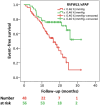Prognostic value of the ratio between right ventricular free wall longitudinal strain and systolic pulmonary artery pressure in patients with heart failure with reduced ejection fraction and ventricular secondary mitral regurgitation
- PMID: 40697996
- PMCID: PMC12279854
- DOI: 10.3389/fcvm.2025.1611772
Prognostic value of the ratio between right ventricular free wall longitudinal strain and systolic pulmonary artery pressure in patients with heart failure with reduced ejection fraction and ventricular secondary mitral regurgitation
Abstract
Background: In heart failure (HF) with reduced ejection fraction (HFrEF), ventricular secondary mitral regurgitation (V-sMR) leads to progressive impairment of right ventricular (RV) function and adversely affects outcomes. Non-invasive indices of RV-pulmonary artery (RVPA) coupling may offer enhanced prognostic value.
Methods: We retrospectively evaluated advanced echocardiographic surrogates of RVPA coupling in 104 HFrEF patients with V-sMR.
Results: Over a median follow-up of 526 days, 48 patients (46.2%) reached the composite endpoint of rehospitalization for HF decompensation or all-cause mortality. Patients who experienced events had significantly larger RV volumes, lower RV functional indices, and higher systolic pulmonary artery pressure (sPAP) compared with those without events. Among the RVPA coupling measures, the ratio of RV free-wall longitudinal strain (RVFWLS) to sPAP had the highest predictive accuracy (area under the curve 0.730), with an optimal cut-off of 0.46%/mmHg (71% sensitivity, 69% specificity). Kaplan-Meier analysis showed significantly lower event-free survival for patients with RVFWLS/sPAP < 0.46%/mmHg (log-rank p = 0.001). In multivariable Cox regression analysis, RVFWLS/sPAP (hazard ratio 0.110, 95% confidence interval 0.012-0.992; p = 0.049) emerged as an independent predictor of adverse outcomes.
Conclusion: The RVFWLS/sPAP ratio, with a cut-off value of 0.46%/mmHg, is a robust, independent prognostic marker in HFrEF patients with V-sMR.
Keywords: heart failure with reduced ejection fraction; prognosis; right ventricular strain to pulmonary artery pressure; right ventricular to pulmonary artery coupling; speckle-tracking echocardiography; three-dimensional echocardiography; ventricular secondary mitral regurgitation.
© 2025 Hădăreanu, Hădăreanu, Toader, Iovănescu, Florescu, Raicea and Donoiu.
Conflict of interest statement
The authors declare that the research was conducted in the absence of any commercial or financial relationships that could be construed as a potential conflict of interest.
Figures



References
-
- Lancellotti P, Pibarot P, Chambers J, La Canna G, Pepi M, Dulgheru R, et al. Multi-modality imaging assessment of native valvular regurgitation: an EACVI and ESC council of valvular heart disease position paper. Eur Heart J Cardiovasc Imaging. (2022) 23(5):E171–232. 10.1093/ehjci/jeab253 - DOI - PubMed
LinkOut - more resources
Full Text Sources
Research Materials
Miscellaneous

